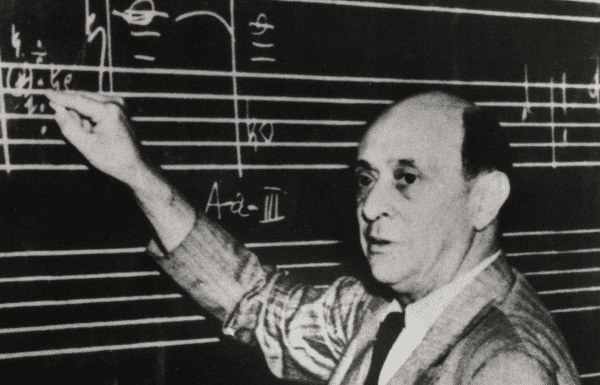
Arnold Schoenberg began his “School of Criticism” with discussions of chamber music, but quickly moved to orchestral repertoire. The choice of repertoire may have been influenced by his desire for students to hear live orchestral performance.
In fact, the Los Angeles Philharmonic performed most of the orchestral works during the 1935–36 season, and in the case of Mozart’s Symphony no. 40, Schoenberg’s Monday evening lecture followed immediately after a performance of the work that weekend. Neither of the students make mention of having attended a live performance, however, and the dates of his lectures do not line up so neatly with other Los Angeles Philharmonic performances.
For want of live performance, Schoenberg turned once again to technology. Phonograph recordings proved a valuable resource, and a series produced by the Minneapolis Symphony Orchestra under Eugene Ormandy in 1934 and 1935 would have been particularly helpful. Schoenberg may have become aware of the recordings because the first work they recorded, on January 16, 1934, was his Verklärte Nacht.
This series also included four of the works Schoenberg lectured on in his series at USC: Sibelius’ First Symphony, Bruckner’s Seventh Symphony, Mahler’s Second Symphony, and Schumann’s Rhenish Symphony. Abrams references the recording of Mahler’s Second in her notes specifically, which, along with the Bruckner recording, sold many copies. The commercial availability of these recordings made the works accessible outside the concert hall, affording Schoenberg’s students the opportunity to hear them repeatedly whenever they chose. In fact, in the back of his 1936 appointment book, Schoenberg wrote, “set a time at which students, with prior notification, can listen to records of their choosing while following along the score.”
In addition to phonograph records, a technology Schoenberg clearly embraced in his teaching was the radio. Radio broadcasts of major symphony orchestras were standard fare at the time, and though they did not offer the repeated hearings inherent in phonograph recordings, they did provide students an economical way to experience a live performance. Strang’s notes from November 18 indicate that the Rhenish Symphony had been on the radio on Sunday, November 17. Perhaps Schoenberg had asked the students to listen to the symphony as a homework assignment in preparation for the lecture the next day.
Schoenberg left USC after only one year, moving to the University of California at Los Angeles (UCLA) in fall 1936. He did not teach music appreciation courses at UCLA, but he likely continued to encourage his students to listen to the radio.
Fundamentally, Schoenberg asked his students to focus on the same basic information that Abrams records in her notes of October 21: key, time signature, genre, performing forces, tempo, general character, and which movement. But the radio worksheet fleshes this foundation out somewhat.
For example, when Schoenberg refers to “general character,” he asks the students to classify their initial impressions of a work, suggesting the following adjectives: “dancelike, songlike, cantabile, lyric, heroic, pathetic, passionate, scherzando, grazioso, rhythmic, fantastic, marchlike, stormy, fiery, noble-spirited, melodious, sentimental, burlesque, grotesque, ironic, folklike, exotic, national characteristic, picturesque, dreamy, descriptive of nature or definite moods, etc.” The worksheet also provides insightful information about how Schoenberg wished his students to categorize art music, including what divisions he perceived in the domains of harmony, orchestration, and form.
For instance, one wonders what the distinctions were in Schoenberg’s mind among the harmonic categories “Romantic,” “chromatic,” and “Wagnerian.” In regards to styles of instrumentation what distinguishes “pre-Beethoven” from “classic,” or “Wagnerian” from the category “Strauss-Debussy-Tschaikowsky and other post-Wagnerian”? Pondering such differences not only reveals more about Schoenberg’s pedagogy in his adopted home, but also furnishes a lens onto Schoenberg’s own reception of Western art music.
Putting scores on a projector, placing recordings on reserve in the library for students to listen to, these activities seem commonplace, if not outmoded and quaint, today. But in their original context, these uses of technology reveal Schoenberg’s willingness to adapt to changing circumstances.
Limited by the availability of scores and public performances, he brought performances into students’ classrooms and homes, in order to continue with a pedagogy he believed would be as successful for his American students as it had been for those he had taught in Europe. As with his later use of liner notes to educate a broad general public, it is clear that in Schoenberg’s classrooms in southern California, pedagogical goals were always foremost in his mind, and that he engaged technology not merely for its own sake, but to serve these noble ends.
If Schonberg were around today, he would likely be on the forefront of the critical use of technology in the music classroom. He would ask first what he wanted his students to be able to do, and only then consider the technological options available to him to help them succeed. The Center in Vienna that bears his name is a testament to that legacy.
A model of a twenty-first century archive, their website boasts digital access to a wealth of materials, including music and text manuscripts, letters, and other artifacts. You can listen to recordings of all of Schoenberg’s compositions, stream audio of Schoenberg speaking, or access videos on their YouTube channel. Anyone teaching about Schoenberg’s music and life in music theory or music history courses can direct their students to these sources.
And by encouraging students to interact creatively and critically with these sources, we not only deepen their understanding of Schoenberg’s musical, theoretical, philosophical, and aesthetic legacy, but we keep his pedagogical spirit alive.